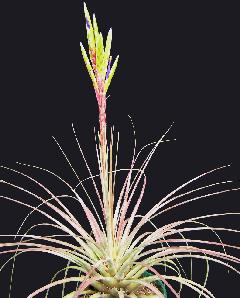
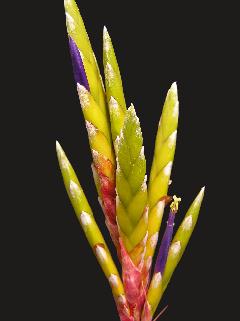
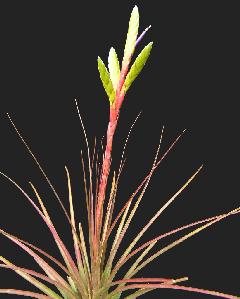
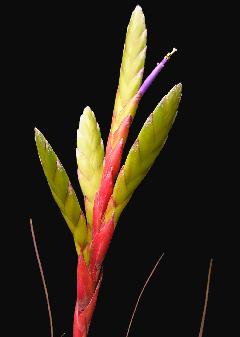
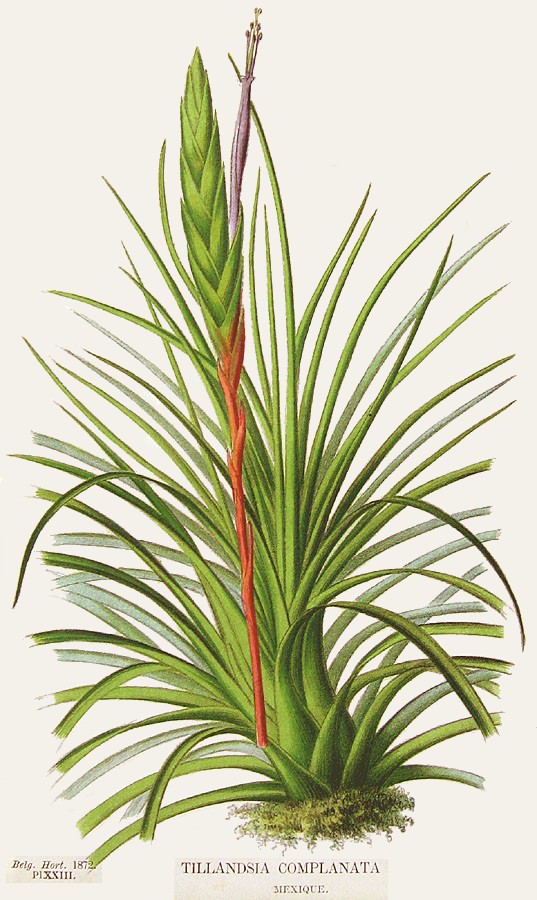
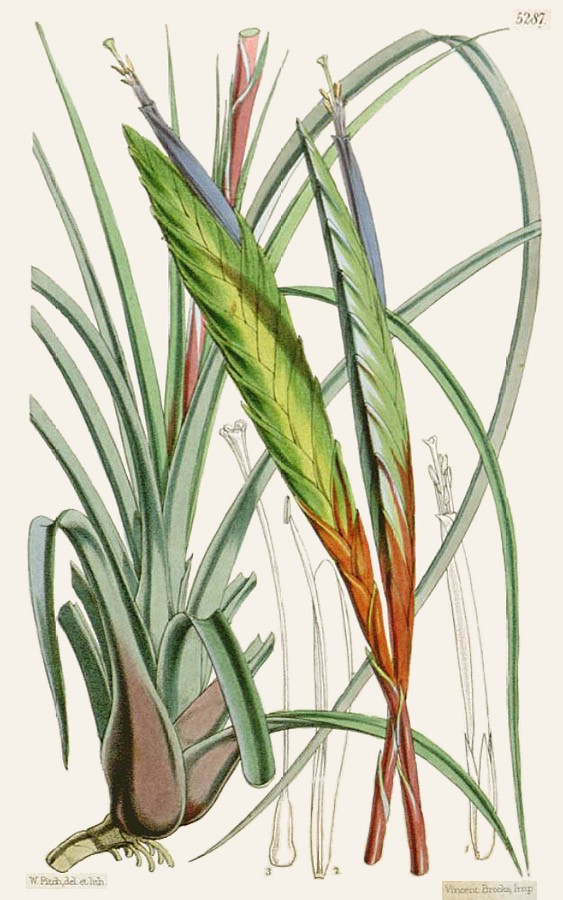
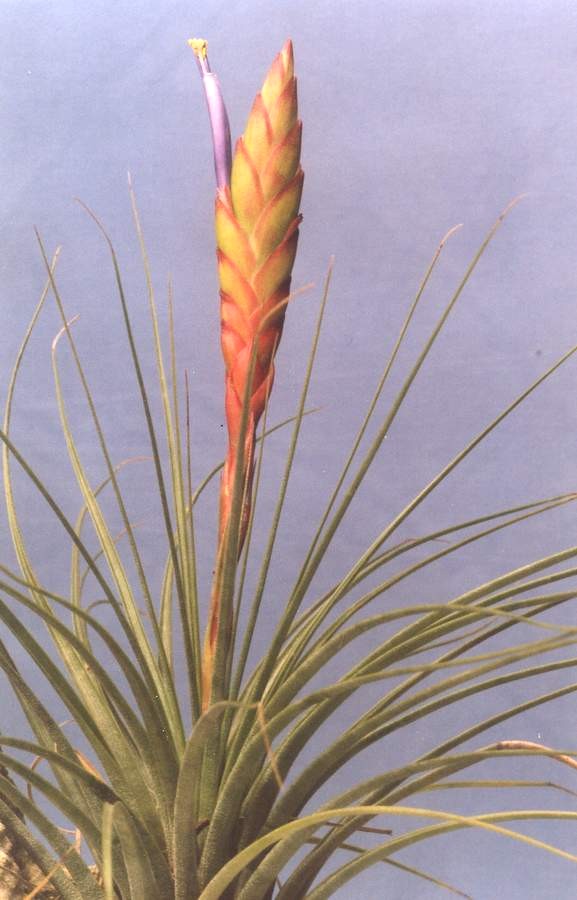
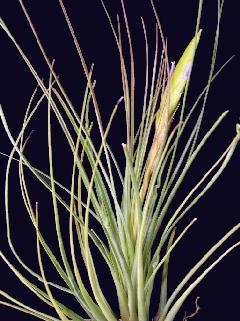
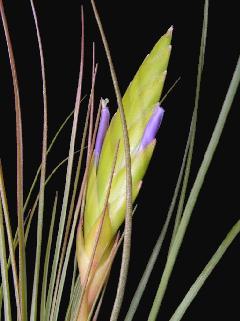
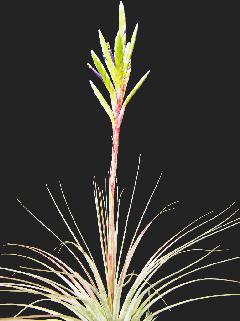
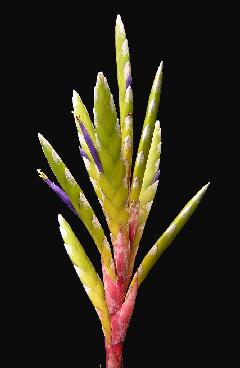
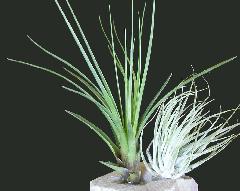
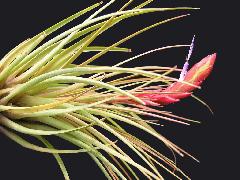
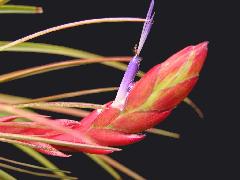
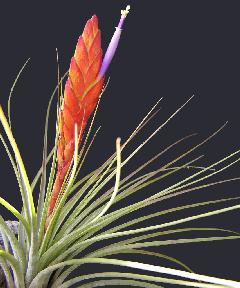
Plant stemless, often propagating by scaly branching rhizomes.(flowering to 30cm high, medium size)
Leaves many in a dense rosette, about equaling or shorter than the inflorescence, the outer ones arched-recurving, densely and minutely appressed-lepidote throughout;( forming a dense vase not in anyway bulbose rosette)
Sheaths elliptic-oblong, large; (brown.)
Blades linear-triangular, long-attenuate, 1 cm wide at the base, glaucous-green. (gradually narrowing to the acute but not pungent tip, to 30cm long and to 10mm wide in the middle, rigid, from sub-erect to curving and spreading, near anthesis the inside wine-red later with narrow and obscurely wine margins the remainder below light green above glaucous green, the back lightly and nearly punctulate lepidote)
Scape erect, slender; (short, strong, strictly erect.)
Scape-bracts erect, involute, densely imbricate, the lower foliaceous, the upper elliptic, acuminate, red. (sheaths densely covering the scape and if not, by the older blades with an acute tip from the lower part, red, involute.)
Inflorescence simple and distichous-flowered or laxly subdigitate from a few spikes; (few flowered, bipinnate panicle, almost equalling the leaves.)
Primary bracts like the upper scape-bracts, scarcely larger than the floral bracts; (much shorter than the spikes, with no blade, all are the same size as the sheaths of the scape bracts)
Spikes erect or divergent, subsessile, linear-lanceolate in outline, acute, cuneate, densely many-flowered, 6-18 cm long, 18-25 mm wide, strongly complanate with flat sides. (dense fan shaped, to 6 flowered, in a typical plant the terminal spike is 60mm long, 12mm wide and a single lateral spike smaller and pinnate,)
Floral bracts erect and very densely imbricate, ovate, acute, 3 cm long, only about 18 mm wide, much exceeding the sepals, six times as long as the internodes, sharply carinate, coriaceous, even, glabrous; (densely imbricate, rigid, smooth, the back towards the tip with dense pale lepidote, much exceeding the sepals, to 20mm long, strongly concave not keeled, tip not incurved not mucronate, lower part red upper green)
Flowers sessile. (subsessile, strictly erect, to 40mm long.)
Sepals lanceolate, acute, 2 cm long, sharply carinate, coriaceous, even, glabrous, much connate posteriorly; (anterior free, posterior joined to the middle, rigid, to 15mm long.)
Petals tubular-erect, 7 cm long, ligulate, obtuse, violet; (a lovely violet, forming a club-shaped tube above, the tip minutely recurved, 20mm longer than the sepals, shorter than the stamens.)
Stamens and pistil exserted. (longer than the stamens.)
Capsule slenderly cylindric, acute, about equaling the floral bracts.
(Type locality Mexico, near Zacuapan)
Key to the Varieties of Tillandsia tricolor
1. Leaf-sheaths uniformly deep castaneous.
2. Plant flowering over 25 cm high; floral bracts and flowers correspondingly large. => var tricolor.
2. Plant flowering not more than 25 cm high. => var melanocrater. Now treated as species in own right
1. Leaf-sheaths more or less pale maculate; plants 15-35 cm high. => var picta.
Tillandsia tricolor var tricolor
Vriesea xiphostachys Hooker, Bot. Mag. 87: pI. 5287. 1861. Type. Kew Hortus s n (n v ), .'Tropical America." In the absence of any specimen typified by the original description and plate.
Tillandsia complanata sensu E. Morren, Belg. Hortic. 22: 300, pl. 23. 1872; non Bentham, 1846. Based on Malzinne in Makoy Hortus (LG? n v ).
Platystachys complanata E. Morren, Belg. Hortic. 22: 300. 1872; nomen in synon.
Vriesea botteri hortus ex Regel, Gartenflora 33: 293, 1884; nomen.
Tillandsia xiphostachys sensu Baker, Handb. Bromel. 170. 1889; in part, as to synonymy, not as to Grisebach, 1865.
Tillandsia botteri E. Morren ex Baker, Handb. Bromel. 183. 1889. Type. Mexico, Morren Icon (K). Now treated as species in own right see Espejo et al Selbyana 25(1):54. 2004
Tillandsia acroleuca Mez & Purpus, Repert. Sp. Nov. 16: 72. 1919. Type. Zacuapan, Vera Cruz, Mexico, Purpus in Konigsberg Hortus (B, B photo 1205/6).
Plant flowering over 25 cm high. Leaf-sheaths uniformly deep castaneous.
TYPE. Schiede & Deppe 1006 (B, B photo 1192/16), Jalapa, Vera Cruz, Mexico. DISTRIBUTION. Epiphytic, 750-2,300 m alt, southern Mexico, Central America.
MEXICO. Vera Cruz; Orizaba, 1855, Muller 1300 (GH); 10 Aug 1924, Fisher 89 (MO US); Cordoba, 25 May 1866, Bourgeau 1768 (GH, US); 6 Oct 1943, Lundell 12529 (GH, LL); 11 Oct 1964, Rzedowski 18879 (IPMEX, US); Mirador, Liebmann 50 (C); May 1929, Skwarra s n (GH); Huatusco, s d, Ghiesbreght 78 (P); Jalapa, Aug 1901, Rose & Hay s n (US); 1938, Foster XI (GH); Zacuapan, Feb 1913, Purpus 6348 (F, GH, NY, UC, US); May 1913, 6417 (UC); Apr 1919, 8225 (GH, NY, US); San Antonio Eloxochitlan, 24 Jul 1938, Schultes & Reko 271 (GH); Fortin de las Flores, 6 Apr 1952, Moore & Cetto 6214 (BH, US). GUATEMALA. San Marcos: Volcan Tajumulco, 26 Feb 1940, Steyermark 36626 (F). Quezaltenango: Patzulin, 6 Jan 1940, Steyermark 33644 (F); 33671 (F); 9 Feb 1941, Standley 85870 (F, GH); 86921 (F, GH); Santa Maria de Jesus, 25 Jan 1941, Standley 84795 (F). Suchitepequez: Volcan Santa Clara, 23 May 1942, Steyermark 46609 (F, GH). COSTA RICA. Cartago: Paraiso, 19 Jan 1932, Kupper 416 (M); Cartago, 23 Apr 1956, Williams 19303 (EAP, US).
Tillandsia tricolor var melanocrater (L. B. Smith) L. B. Smith, Jour. Wash. Acad. 43: 68. 1953. NOW SPECIES IN OWN RIGHT
Tillandsia melanopus E. Morren ex Mez, DC. Monogr. Phan. 9: 680. 1896; in part, not as to type. Based on Cooper 261 (US), Cartago, Costa Rica, Jan 1887.
Tillandsia melanocrater L. B. Smith, Contr. Gray Herb. 117: 31,pl. 2,fig. 34. 1937.
Plant flowering not more than 25 cm high. Leaf-sheaths uniformly deep castaneous. TYPE. Cooper 261 .(holotype US), Cartago, Costa Rica, Jan 1887.
DISTRIBUTION. Epiphytic in forest, 70-1500 m alt, Central America.
GUATEMALA. Alta Verapaz: Coban, Feb 1908, Tuerckheim II-2186 (GH, US); 1939, Standley 71580 (F); Tucurri, s d, Johnson 1086 (US); Tamahu, 5 Apr 1939, Standley 70910 (F); 10 Apr 1941, 92045 (F); 92049 F); Tactic, 14 Apr l941, Standley 92637 (F, GH); 92653 (F); 20 Feb 1942, Steyermark 43985 (F, GH, US). San Marcos: Rodeo, 15 Mar 1939, Standley 68939 (F). Suchitepequez: Volcan Santa Clara, 23 May 1942, Steyermark 46704 (F, GH). NICARAGUA. Matagalpa: San Ramon, 1963, Heller 5647 G); 5687 (F); Santa Maria de Ostuma, Jan 1963, Williams 23304 (F);Williams, Molina & Williams 23625 (EAP, F, US); 18 Jan 1965, Willinms et al 27892 (F, EAP, US). Jinotega: 1947, Standley 9527 (F); Jinotega, 13 Jan 1965, Williams et al 27 504 (EAP, F, US). COSTA RICA. Guanacaste: Tilaran, Jan 1926, Standley & Valerio 44504 (US); 44782 (US); Rio Liberia , 25 Jan 1930, Dodge & Thomas 5371 (GH). Alajuela: San Ramon, Apr 1913, Tonduz 17897 (US); Zarcero, 25 Nov 1937, Smith A-543 (F). San Jose: Aserri to Tarbaca, 6 Dec 1925, Standley 41371 (US). Cartago: Cartago, Jan 1887, Cooper 5954 (US); Feb 1924, Standley 33349 (US); 33397 (US); Volcan lrazu, Dec 1894, Pittier 9107 (US); 7 Apr 1953, Moore 5669 (BH, US); Las Vueltas, Tucurrique, Mar 1899, Tonduz 13295 (G-B, US); Cerro de La Carpintera, Feb 1924, Standley 34258 (US); 1 Nov 1929, Dodge & Thomas 5425 (GH); Dulce Nombre, 27 Feb 1924, Standley 35891 (US); Finca Las Concavas, Dec 1925, Standley 41518 (US); 17 Dec 1948, Foster 2701 (US); 2702 (US); 2703 (US); Rio Reventado, 26 Feb 1926, Standley & Valerio 49412 (US); El Muneco, Rio Navarro, Mar 1926, Standley & Torres 51775 (US); El Alto, 1937-38, Allen 663 (F, GH); San Isidro, 11 Feb 1938, Valerio 1724 (F); SierraTalamanca, 13 Jul 1962, Haines 25 (US); 26 (US). PANAMA. Chiriqui: Boquete, 4 Mar 1911, Pittier 2987 (US); Jul 1938, Woodson, Allen & Seibert 1129 (GH); Woodson & Schery 807 (GH, US); 808 (GH). Canal Zone: Summit, 4 Jan 1924, Standley 29561 (US); Quebrada Salamanca, 16 Dec 1934, Dodge, Steyermark & Allen 17033 (GH); Quebrada Ancha, 18 Dec 1934, Dodge & Steyermark 17033-A (GH). Colon: Porto Bello, Jan 1911, Pittier 2473 (US).
Tillandsia melanocrater L. B. Smith, Spec Nova. Contr. Gray Herb. 117: 31,pl. 2,fig. 34. 1937.
acaulis, haud ultra 25 cm. alta; foliis pluriuris, subpatentibus, rosulatis, 15-20 cm. longis, utrinque densissime minuteque adpresso-lepidotis ; vaginis late ovatis, valde conspicuis, atro-castaneis; laminis lineari-triangularibus, longe acuminatis, pungentibus, basi 8 mm. latis, planis; scapo erecto vel adscendenti, gracili; scapi bracteis erectis, dense imbricatis, late ovatis, lepidotis, infimis vel fere omnibus lineari-laminatis; inflorescentia simplici vel paupere digitata; bracteis primariis scapi supremis similibus, quam bracteae florigerae vix majoribus; spicis variabilis, e anguste oblongis et acutis ad late ellipticis et obtusis , 4-9 cm. longis, valde complanatis, ad basin versus bracteis sterilibus saepe auctis; rhachi gracili, fere recti; bracteis florigeris erectis, imbricatis, sed saepe rhachin non omnino obscurantibus, ovatis, acutis vel obtusis apiculatisque, 20-25 mm. longis, 9-12 mm. latis, sepala superantibus, quam internodia 3-6-plo longioribus, valde carinatis, coriaceis, laevibus, glabris vel ad apicem versus parce lepidotis; floribus subsessilibus; sepalis lanceolatis,. acutis, posticis alte connatis; petalis tubuloso erectis, angustis, 30-35 mm. longis, violaceis; staminibus styloque exsertis; capsulis graciliter cylindricis, acutis, 3 cm. longis. Pl. II, fig. 34.
GUATEMALA: Alta Verapaz: Coban, alt. 1350 m., 1908, Tuerckheim II 2186 (G, US). COSTA RICA: Cartago: Cartago, 1887, Cooper 261 (US, TYPE; phot. G); northwest slope of Cerro Carpintera above La Union de Tres Rios, alt. 1320-1700 m., 1929, Dodge & Thomas 5425 (G); Guanacaste: along Rio Liberia near Hacienda Santamaria, alt. 640-680 m., 1930, Dodge & Thomas 6371 (G). PANAMA: Canal Zone or vicinity, westerly arm of Quebrada_Salamanca, alt. 70 m., 1934, Dodge, Steyermark & Allen 17033 (G); drowned forest of Quebrada Ancha, alt. 70 m., 1934, Dodge & Steyermark 17033a (G).
In publishing Morren's Tillandsia melanopus Mez noted two elements without naming either and designated as typical the first which consisted of only one collection, Pfaff 254. An examination of this specimen in the herbarium at Liege shows that it is not separable from T. punctulata. Consequently there is no choice but to reduce typical T. melanopus to synonymy and choose a name for Mez's second element which is a valid species. The number selected as a type under the new species is one of those originally cited by Mez.
Translated by Butcher
Plant stemless, not at all more than 25cm high.
Leaves many, almost spreading, rosulate, 15 – 20cm long, both sides very dense minute appressed lepidote.
Sheath broad ovate, decidedly conspicuous, blackish brown.
Blade linear-triangular, long acuminate, pungent, 8mm wide at base.
Scape erect or ascending, slender.
Scape bracts erect, densely imbricate, broad ovate, lepidote, the bottom ones or nearly all with linear blades.
Inflorescence simple or poorly digitate.
Primary bracts similar to the upper bracts, barely larger than the floral bracts.
Spikes, variable, from narrow oblong and acute, to wide elliptic and obtuse, 4 – 9cm long, strongly complanate, often with a sterile bract towards the base.
Rhachis slender, nearly straight.
Floral bracts erect, imbricate, but often not totally obscuring the rhachis, ovate, acute or obtuse apiculate, 20 –25mm long, 9 – 12mm wide, exceeding the sepal, 3 – 6 times longer than the internodes, strongly keeled, leathery, smooth, glabrous or a few lepidote towards the tip.
Flowers subsessile.
Sepals lanceolate, acute, posterior high connate.
Petals tubular erect, narrow, 30 – 35mm long, violet.
Stamens exserted.
Capsule slender cylinder, acute, 3cm long.
Tillandsia tricolor var picta L. B. Smith, Contr. Gray Herb. 154: 38, 1945. Treated as a synonym of T. tricolor var. tricolor in Binomial listing 2008 – no reason given but Gouda 6/2013 considers a variety in own right.
Plant flowering 15-35 cm high. Leaf-sheaths more or less pale-maculate.
TYPE. Standley 92046 (holotype F), Rio Polochic, above Tamahu, Alta Verapaz, Guatemala, 10 Apr 1941.
DISTRIBUTION. Epiphytic in forest, 1200-1400 m alt, Central America.
GUATEMALA. Zacapa: Santa Rosalia de Marmol to Vegas, Sierra de las Minas, 19 Jan 1942, Steyermark 42900 (F, GH). HONDURAS. Comayagua: Valibrea, 7 Apr 1945, Rodriguez 2775 (F); Barranco de Trincheras, Siguatepeque, 1951,Williams 18458 (EAP, US). Paraiso: Manzaragua, 7 Feb 1956, Williams & Molina 19023 (EAP, US). NICARAGUA. Jinotega: Cerro Sialci, Jinotega, 1 Jul 1947, Standley 10600 (F). COSTA RICA. Puntarenas: Sabalito, 10 Mar 1966, Smith 15319 (US).
Treated by S&D as a synonym of T. tricolor see above
Tillandsia acroleuca Mez & Purpus, Repert. Sp. Nov. 16: 72. 1919
Detail from Mez 1935
Plant stemless, flowering to 30cm high, medium size.
Leaves numerous, forming a dense vase not in anyway bulbose rosette.
Sheath brown.
Blade gradually narrowing to the acute but not pungent tip, to 30cm long and to 10mm wide in the middle, rigid, from sub-erect to curving and spreading, near anthesis the inside wine-red later with narrow and obscurely wine margins the remanider below light green above glaucous green, the back lightly and nearly punctulate lepidote.
Scape short, strong, strictly erect.
Scape bracts sheaths densely covering the scape and if not, by the older blades with an acute tip from the lower part, red, involute.
Inflorescence few flowered, bipinnate panicle, in a typical plant the terminal spike is 60mm long, 12mm wide and a single lateral spike smaller and pinnate, almost equalling the leaves.
Primary bracts much shorter than the spikes, with no blade, all are the same size as the sheaths of the scape bracts.
Spikes dense fan shaped, to 6 flowered,
Floral bracts densely imbricate, rigid, smooth, the back towards the tip with dense pale lepidote, much exceeding the sepals, to 20mm long, strongly concave not keeled, tip not incurved not mucronate, lower part red upper green.
Flowers subsessile, strictly erect, to 40mm long.
Sepals anterior free, posterior joined to the middle, tigid, to 15mm long.
Petals a lovely violet, forming a club-shaped tube above, the tip minutely recurved, 20mm longer than the sepals, shorter than the stamens.
Style longer than the stamens.
Type locality Mexico, near Zacuapan
Detail from Baker 1889
53. T. XIPHOSTACHYS Griseb. in Gotting. Nacht. 1864, 14.
Vriesea xiphostachys Hook in Bot. Mag. t. 5287.
T. complanata E. Morren in Belg. Hort. 1872, 300, t. 23 (M.D.), non Benth.
Leaves 30-40, densely rosnlate, linear-subulate from an ovate base ¾in. diam., 6-9 in. long, ¼-? in, broad at the base of the blade, firm in texture, tapering gradually to a long point, thinly lepidote.
Peduncle 6-9 in. long;
bract-leaves small, adpressed, imbricated.
Inflorescence a dense simple spike 4-5 in. long, ¾-1 in. diam.;
flower-bracts oblong, acute, 1-1¼ in. long.
Calyx shorter than the bract;
sepals acute.
Petals lilac, three times as long as the calyx, convolute in a cylindrical tube shorter than the stamens.
Hab. Mexico, near Cordoba. Flowered by M. Jacob Makoy at Liege in 1871. Mountains of Venezuela, Fendler 3447. Originally described from cultivated specimens at Kew in 1861.
Protologue
1006. Tillandsia tricolor n. sp. Schlechtendal & Chamisso, Linnaea 6: 54. 1831.
habitu et statura superioris speciei, diversa; spica ramosa, bracteis et floribus minoribus, capsulis bracteas superantibus et squamis evidentioribus subfurfuraceis. Squamae parvae, umbone depresso, margine scarioso albo. Folia paulo crassiora et rigidiora. Caulis paulo gracilior pariter imbricatus. Inflorescentia folia superans. Racemus distichus, confertus, e spicis compositus 4-6 alternis distichis lancelolatis. Bracteae naviculares, sub maturitate fructus stramineae, laevis, enerviae, glabrescentes, apice tantum lepidotae, arcte imbricatae, marginibus subreflexis.
- - Jalapae in arboribus parasitica. Aug. sub anthesi.
His plant differs from T. tricolor in:
1) Only posterior sepals are keeled
2) Posterior sepals joined for only l/2 length.
So at the moment I believe the plant is a T. tricolor even though I haven't seen the stamens exsert.
I am aware that Harry Luther has been moving names from inserted stamens section to exserted stamens section as with T. rhomboidea, but in this case I think it is the plant that is "doing the Irish".
If any of you out there has another of Maurie's ? T. balbisiana please tell me if the stamens are exserted. A drawing has been included to help you with your decision.
Butcher’s dissection
Plant stemless, rosette leaves numerous, 40cm diam, 40cm high when flowering
Leaf sheath distinct, 2.5cm wide, 4cm high, dull brown inside, outside green, nerved top portion then brown then white.
Leaf blade 30cm long, 1.5cm wide near sheath, narrow triangular, tapering to a point, strongly channelled, top 5cm terete, light grey scaled appressed on both sides.
Scape 15cm long, 0.5cm diam, red, internodes 2cm apart,
Scape bracts leaf like with red base covering scape, becoming more red with shorter green blade with scape becoming visible, finally last 2 bracts totally red with blade only 1.5cm long,
Inflorescence polystichous, lax, 20cm high, 10cm wide, compound with 5 spikes, rhachis visible, internodes 1cm apart, red with grey scales
Primary bracts similar to upper scape bracts but blade now down to 0.5cm long,
Spike side spikes to 10cm long, 6-7 flowered, top spike to 14cm long, 1.5cm wide, complanate, distichous, rhachis not visible, bottom 2-3 bracts sterile,
Floral bracts glabrous with a few scattered scales at tip, keeled, green with a pinkish overlay, exceeding sepals
Sepals 2.2cm long, 0.5cm wide, glabrous, green with a pink tip, posterior pair keeled and connate,
Petals forming a tube, 2.6cm long, violet blue with white slightly flared tip,
Stamens and Style included,
Thoughts in 2007
If Maurie had got his seed as T. balbisiana I could have understood why this plant also has the looks of T. xsmalliana!!
In Dec. 1986 I wrote to Werner Rauh
EM 82223 collected in 1982 near Ocosingo Chiapas belongs to T. tricolor/ punctulata
It differs from T. tricolor by sheath to 2.5cm not 1cm
Spikes 1.5cm wide not 1.8–2.5cm
Internodes 4times as long as the bracts (not 6 times)
Floral bracts 2.1cm long , 1.3cm wide not 3cm x 1.8cm
Petals 3cm long ( not 7cm in S&D) not obtuse but acute
Stamens included or post floral as long as the petals.
I never got an answer. Lotte at this time also thought it might be something different.